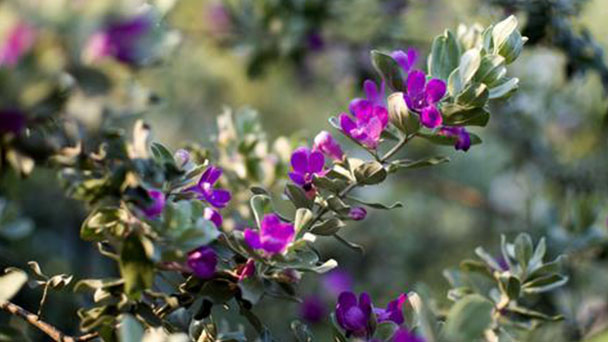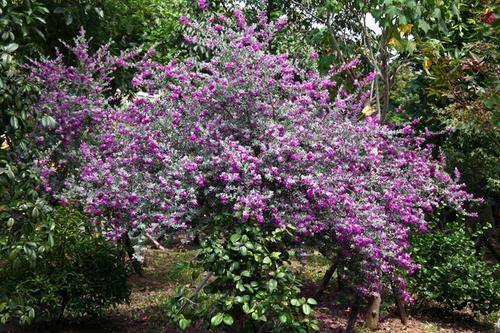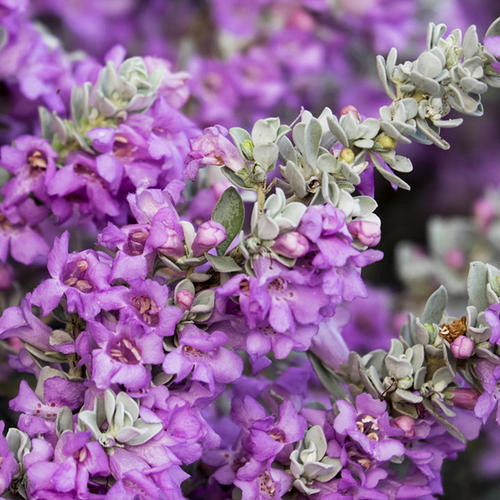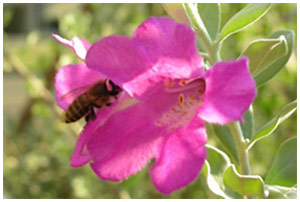Texas Sage (Leucophyllum Frutescens) Profile: Plant Info & Care
Written by Maggie
Dec 07 2021

Texas Sage, scientific name Leucophylum frutescens, also Known As: Rain Sage, Barometer Bush, Purple Sage, Texas Ranger, Cenizo, is a plant of the family Sphalophoraceae.
Texas Sage Picture

Characteristics of Texas Sage
Texas Sage is an evergreen shrub, plant height about 30 ~ 150 cm, alternate leaves, elliptic row or obovate, often about 2 ~ 4 cm, densely covered with silvery white hairy, thick, whole margin, slightly curly, such as silvery white hibiscus. Summer and autumn flowering, axillary, corolla bell line, five lobed, purplish red, extremely beautiful, unique leaf color, long flowering.
Ecological Habits of Texas Sage
Texas Sage has cold resistance, drought resistance and heat resistance, belongs to the positive plant, like to grow in a warm and slightly arid environment.
Distribution of Texas Sage
Texas Sage distributes in Mexico in Central America to Texas in North America.
Propagation of Texas Sage
Texas sage propagation can be cuttage, high pressure method, spring is the appropriate period.

How to Care for Texas Sage
Light for Texas Sage
Texas Sage likes plenty of sun and can't tolerate shade. Even in hot summer, there is no need for shade. Direct sunlight is more conducive to the growth of Texas Sage and improves its ornamental quality. In the absence of sufficient light, texas sage leaves and branches will be empty, the plant shape is not compact, and the color of the leaves will change from silver to light green. If need to move into the shade of the bedroom ornamental, can only be a short period, ability does not affect the growth of the plant. But seedlings of the young plants fear sun exposure, and should pay attention to appropriate shade.
Watering Texas Sage
Texas Sage has drought resistance, not water collapse, watering to master the "rather dry not wet", do not let the basin soil over wet and waterlogging. Usually water to water thoroughly, when the air is dry to Texas Sage water, increase air humidity, avoid leaf scorch. In the rainy season, drainage should be timely to prevent waterlogging, otherwise water accumulation in basin soil will easily lead to root rot of Texas Sage. The Texas Sage placed outdoors should be checked and emptied of the water in the basin after rain. Winter low temperature, more attention should be paid to the control of water.
Texas Sage Fertilizer Care
Texas Sage likes fertilizer, fertilizer to master the first thin then concentrated, small amount of frequent application and reasonable combination of nitrogen, phosphorus, potassium principle.In the growth period every 10~15 days topdressing water, growth later and flower after the fruit-setting period, topdressing phosphorus and potassium fertilizer, but also foliar spray 0.2% urea plus 0.1% potassium phosphate dihydrogen. The use of organic fertilizer must be ripe, high temperature weather should stop fertilizer or apply a small amount of inorganic fertilizer. Potted Texas Sage changes the pot once every 2 years. In autumn or when changing the pot, basic fertilizer should be applied. Generally, rotten cake fertilizer or barnyard manure should be used, with 20~100 grams per pot.
Texas Sage Diseases & Insect Pests
Texas Sage has strong disease resistance, fewer diseases and insect pests, common leaves black spot or brown spot, powdery mildew, aphid, red spider, scale insects and leaf-eating pests, to timely check and control, leaf spot can be 50% carbendazim or 75% chlorothalonil 800~1000 times, powdery mildew can be triazolone 1000 times control. Texas Sage's aphids are heavier, and when they are found, they are sprayed to kill 1,000 times more pyramids. In the larval stage from May to July, the scale insects were killed with 40% rate and sprayed with 1000 times twice or three times. Anther spider was controlled with 15% acaroid cream 2000 times.
Texas Sage Value
The whole plant leaves are thick, leaf color is unique, and can be used for viewing leaves; Texas Sage is an elegant short shrub with long flowering period, landscaped, trimmed, low hedged or potted.

Read Next:
Top 10 Most Beautiful Roses in the World
Top 10 Most Beautiful Flowers in the World
26 Best Autumn Flowers to Plant for Fall Color in Garden
Latest Updated
- Benefits of Bugleweed - 7 Science-backed Health Benefits
- Bugleweed Dangers & Side Effects - Is It Poisonous?
- How to Plant Evergreen Trees - What You Should Know
- When to Plant Evergreens - Grow Guide for Evergreen Trees
- 12 Wonderful Evergreen Shrubs for Your Garden
- 12 Popular Evergreen Plants with Pictures for Beginners
- When And How To Prune A Lilac Bush Like a Pro
- How to Grow & Care for Lilac Vine (Hardenbergia Violacea)
- Japanese Lilac Tree (Syringa Reticulata) Care & Propagation Guide
- Shumard Oak Pros and Cons - What to Know
Popular Articles
- Winter maintenance of Antirrhinum Majus
- How to Grow Terminalia Mantaly Tree
- How to Grow and Care for Crossostephium Chinense
- How to grow Antirrhinum Majus in spring
- Peristeria Elata (Dove Orchid) Profile: Info & Care Guide
- Underwatered Snake Plant (Sansevieria Trifasciata) - Signs And How To Fix
- How to Care for Brazilian Jasmine Plant (Mandevilla Sanderi)
- How to Grow & Care for Graptopetalum Purple Delight in Summer
- Rosa Chinensis (China Rose): Plant Growing & Care Tips
- How to Care for Baby Sun Rose (Aptenia Cordifolia)